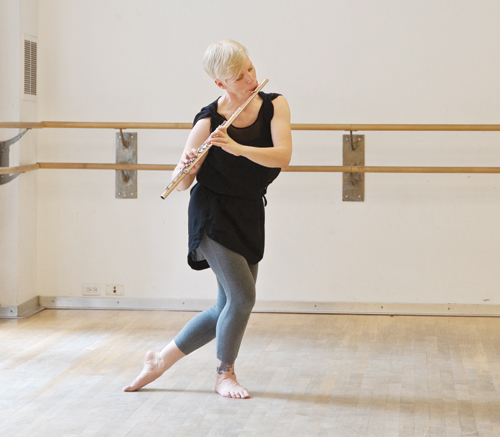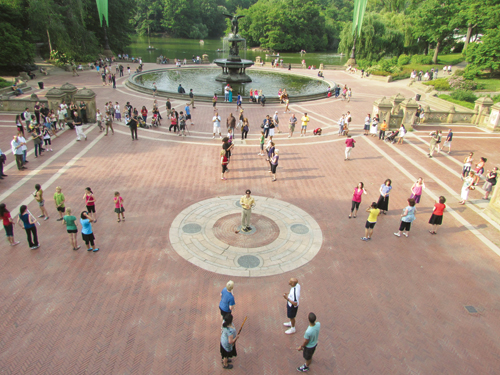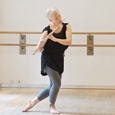
Zara Lawler examines unusual musical possibilities by combining the flute with theater, dance, and other instruments to create surprising, creative performances. She is known for her solo interdisciplinary program The Flute on its Feet, her duo with marimba player Paul J. Fadoul (Lawler + Fadoul), as well as her events for many moving flutists, including a 2012 production of Salvatore Sciarrino’s music for 100 migrating flutists at New York’s Guggenheim Museum.
Why did you start combining flute playing with theatrical staging?
I have always loved a spectacle. In school orchestras, playing for ballet or opera was always my favorite thing because it felt like we were part of something bigger. I also love connections. I love seeing how an idea in music can get translated into an idea in dance, or how a theatrical event can create a sense of drama in music. I did gymnastics and dance when I was young and enjoyed harnessing the energy in the body and using that to propel a dance phrase or a gymnastic combination. As a young flutist, I felt the same way about playing the flute, as it used the energy of the breath to propel a phrase. Eventually I wanted to be able to do both at the same time.
What was involved in the Sciarrino performance at the Guggenheim?
It was a pretty amazing event. The Guggenheim wanted to host the US premiere of Italian composer Salvatore Sciarrino’s Il Cerchio Tagliato Dei Suoni, and they asked me to direct it. The piece is for four soloists (Claire Chase and Eric Lamb, both of the International Contemporary Ensemble, Jayn Rosenfeld, and Kelli Kathman) with 100 migrating flutists or migranti. The title of the piece means Cutting the Circle of Sounds, and Sciarrino asks that the soloists be arranged in a circle around the audience. The music the four soloists play is written to sound as though it is spiraling around the audience, creating a circle of sound. The migranti play while walking a diagonal path through the audience, cutting the circle. The famous rotunda of the Guggenheim was the perfect location. I recruited the migranti, taught them their parts, and staged the entire piece.
Where did you find the 100 flutists?
I used my contacts in the flute community, and the New York Flute Club helped spread the word as well. There were several teachers in town who were happy to have their students included. I think the Guggenheim has a magical quality that really captured people’s imaginations and made them want to participate.
The piece is written so that the flute parts can be played by even young beginners. In fact, since many of the sound effects are supposed to be breathy and very quiet, beginners may even have an advantage over flutists who have spent years developing a big, full sound. This meant that the performance was open to participation by any flutist, and we had some who were as young as seven or eight years old and at least one adult beginner who had only been playing for a year. At the same time, more sophisticated flutists had the satisfaction of participating in the US premiere of a major work by a living composer at a spectacular location. We had many great players, including Carol Wincenc, Wendy Stern, Elizabeth Buck, and Magda Schwerzmann, in addition to the four soloists.
What was your first experience combining dance or theater with music?
After I left school I was interested in this idea but did not know any dancers. I put up a sign at performance space in New York City that said “Flutist Available for your Project,” and included my phone number. It felt very bold. A choreographer named Ellen Young called me to work together on a project. I played three solo pieces which she choreographed for her company. On the same program, I played the Varèse Density 21.5 with a simple choreography that Ellen created for me; I walked as I played. It was mild compared to some of the work I have done since then, but it was a thrilling challenge at the time.
How did that evolve into the work you are doing today?
There were many years and many stages in between. The most notable of those formative experiences is the time I spent with the ensemble Tales & Scales. We performed everything from memory so we could move and act as we played, combining music and story. This was completely different from the usual experience of a musician who stands to the side accompanying a dancer. We created a new work every year with a creative team that included a playwright, composer, stage director, and the members of Tales & Scales. We always tried to raise the bar and challenge ourselves. Those years taught me many of the skills I now use and also opened my mind to the breadth of possibilities in combining performing arts.
Do you still perform any of that repertoire?
No, I left Tales & Scales in 2008. However I still perform with other former members of the group including Neil Parsons who has choreographed several pieces for me, Paul Fadoul (marimba), my partner in the Lawler + Fadoul Duo, and Christopher Grymes (clarinet) who plays on our CD. Gary Race, stage director for Lawler + Fadoul’s educational programs and consultant for several Flute on its Feet pieces, is also someone I know from Tales & Scales.
How do these experiences affect your more traditional performances?
I think it has given me a real appreciation for the primacy of the airstream. When you are bending over backward, the only way you can continue to make a good flute sound is to have a really strong airstream. I also think it has helped me to loosen up about little details that flutists tend to be uptight about. I use fake fingerings all the time, for example, to make things like intonation work in the context of a movement sequence or to be able to play a passage one-handed. When I was a student, I used to feel guilty about that kind of thing. I thought it meant I was not a real flutist if I used fake fingerings. Now, because I am thinking of a bigger picture, I can let go of that feeling and just do what works.
Do you ever feel that adding extra elements takes away from the music?
No, I think it only heightens the experience. Music is a visual medium as well as an aural one. Even at a traditional concert, audiences watch as much as listen. The performers’ body language, the clothes they wear, the lighting, and so on, all have an impact on the experience. I think ignoring, or worse, denying the visual aspect of music hurts the music more than emphasizing it in a beautiful and artful way ever could.
What advice would you offer to those who want to add other elements to their performances?
The main thing is that if you have an idea, just try it. Don’t be scared. Trying something experimental does not commit you to a lifetime of wacky performances, but it may open up new avenues of communication. See the Basic Principles of Interdisciplinary Practice below. Choreographer Neil Parsons and I use this list when we do workshops for The Flute on its Feet.
What is The Flute on its Feet?
This is my solo interdisciplinary recital program. It is solo flute music that is performed in combination with movement and words. The repertoire changes over time as my collaborators and I create new works. Currently, it includes composer Edie Hill’s This Floating World, which is a set of five pieces inspired by Japanese haiku. I have created a version of them where the text is woven into the music, and the whole thing is staged to trace a woman’s journey from anger, isolation, and near-despair to hope, connection, and the prospect of new adventure. There are two dance works on the program that were choreographed by Neil Parsons who performs them with me: Fantasies, using several of Telemann’s solo pieces, and Lowell Liebermann’s Eight Pieces. You can see video of some of the Telemann and Liebermann on my website, zaralawler.com. I also use the title The Flute on its Feet for my workshops for flutists, as a tag line for my company, and as my twitter handle.
What are the challenges of combining music with the other arts?
There are really several levels of challenge. The first is artistic: what do I want to say with a particular piece and how can I best say it? Then there is the physical challenge of moving while playing. I am particularly interested in being able to move with abandon while I play. Sometimes I feel that having the flute in my hands or at my lips necessitates a certain reserve in my physical movements because on some level I am always protecting the instrument. I am experimenting with ways to be freer in my movement.
The other level is more entrepreneurial, such as finding presenters to book the work and donors to fund the creation of new works, as well as keeping track of the business side of things and making ends meet. Having spent most of my professional career with two institutions (Tales & Scales and the Hong Kong Philharmonic), I do find being on my own is a whole new ball game. It can be extremely difficult to do both the artistic and the business sides. It is hard to practice when I feel that I have a laundry list of business emails to write.
What is it like acting as the conductor for the theatre production A Female Philoctetes?
It was such an interesting project. My friend Ralph Farris, composer and violist of ETHEL, wrote the music for a modern staging of Sophocles’ Trojan War story, Philoctetes. I was the only instrumentalist, but led the chorus from the flute. It was a real workout, not just as a flutist, but dramatically as well, since I had to pace the music with the drama. Some of the music was written out and planned very carefully, and some was improvised during performance based on melodic fragments provided by Ralph.
What’s next for The Flute on its Feet?
I have a couple of new projects in the beginning phases of development. One is a set of etudes for interdisciplinary flutists that will feature exercises to teach some basic skills of integrating moving, speaking, and playing. The idea is to keep the etudes simple, so that players do not have to learn all of the performing skills at the same time. For example, one etude will feature walking with the beat, the next will include walking the rhythm, and a third will have the flutist walk a rhythm that is in counterpoint to the one played. There will be exercises for alternating between speaking and playing, and some dedicated to moving specific parts of the body. I am hoping to come up with things that are simple enough to be learned easily, but beautiful enough to be suitable for performance. I am also working on staging a set of folksongs using not only the tunes but the text as well, and also including some opportunities for audience involvement. As part of the folksong project, Neil Parsons and I are collaborating on a choreography for Caen Thomason-Redus’ Amazing Grace Variations.
.jpg)
What led to the Lawler + Fadoul new CD Prelude Cocktail?
Marimbist Paul Fadoul and I have been playing together for many years and wanted to record a CD. We decided to arrange some of the piano preludes of Bach, Shostakovich, Chopin, Debussy, and Gershwin, and then commission new preludes from Katherine Hoover and Roshanne Etezady. It seemed like a big mix of things, hence the name Prelude Cocktail.
The Prelude Cocktail project will continue for a while longer. This year we are publishing at least some of our arrangements, so that other musicians can play them. This is part of our mission to increase the good quality repertoire for flute and marimba (and alto flute and piccolo and vibraphone, etc.). We are also collaborating with a mixologist here in New York to create a cocktail menu to go with the program. That is a real crossing of disciplines, and it has been very interesting to hear her thoughts on our music and how she is translating it into a drinks menu.
Lawler + Fadoul’s next program is one we are really excited about. It is going to be a neo-vaudeville extravaganza. It will be a staged concert of music that is uniquely North American, but presents music that rarely makes its way to the concert stage such as advertising jingles, TV theme songs, ringtones, video game music, hold music, and more. It will be an experiment to feature music that is normally ignored and create something that draws attention to and puts a twist on repertoire that was never intended to be anything other than a marketing device. Each piece will be fully choreographed or staged as acts in a variety show and will range from madcap and silly to beautiful and meaningful.
E Pluribus Flutum was an event for many moving flutists created by Zara Lawler for the closing concert of the 2011 NFA Convention, shown below in a preview performance in Central Park. (photo by Dave Ackerman)

* * *
In 2014, Lawler was flutist and conductor for Aquila Theatre’s production of A Female Philoctetes, with music by Ralph Farris. Her duo with marimbist Paul J. Fadoul (Lawler + Fadoul) creates and commissions new works, and they released their critically acclaimed debut CD Prelude Cocktail in 2013. In addition to performing, Lawler teaches privately in New York City, and is on the faculty of Manhattan School of Music Precollege. Lawler has a Master of Music from Juilliard where she studied with Carol Wincenc and Sam Baron. Her other teachers include Judith Mendenhall and Susan Rotholz.
She comments, “I always think of myself as having a Moyse lineage. My main teachers, Wincenc, Mendenhall, and Rotholz, were all Moyse students. The focus on airstream, expressivity, a methodical approach to skill building, and developing a strong enough technique to feel freely musical in performance are all part of the Moyse legacy.”
Lawler’s Basic Principles of Interdisciplinary Performance Practice
1. There is no need to be an expert to try it. You do not need years of ballet training to move creatively, nor do you need elocution lessons to speak well. If you want to experiment with moving or speaking, just give it a try.
2. Start with a spark of inspiration, and then add depth later. Just as musical interpretation deepens as you learn a piece, extra ideas will develop the more you work with them.
3. Try it before you deny it. If you approach this kind of project with an attitude of exploration and experimentation, you may be surprised at what you can do.
4. Follow the Robert Dick Rule: Don’t do anything that hurts you or the instrument.
5. When in doubt, practice with a stick instead of your flute. I use my high school flute as a middle-rung stage between practicing with a stick and using my gold flute.
6. Get an outside eye before the first performance. If possible, get feedback from a non-musician, perhaps a friend with a background in dance or theater, or someone who is a savvy audience member.
7. Know that everything can appear meaningful to an audience. Musicians assume, incorrectly, that audience members ignore certain parts of the performance, such as walking on stage or adjusting music stands. They will watch your every move, so think about every moment on stage.
8. Get in touch with the composer, if possible. While they say that asking for forgiveness is better than asking for permission, it would be a shame to choreograph something beautifully and then not be able to use it because the composer is opposed to the project.
9. Even if a performance does not include interdisciplinary elements, the exploration process may yield benefits. Opening yourself up to more creativity is always good.
10. Give the audience a chance to just hear you play. In a performance with lots of elements, remember that not everything has to happen all at once all the time.
Memorization Tips
I often perform from memory. There is no big secret to memorization, it just takes lots of time and careful, thoughtful work. The following are some basic guidelines that can help.
• The vast majority of the work time should be spent on memorizing very small chunks of music. Working in small chunks is important in regular practice, but it is crucial in memorization.
• Chunks should be small enough that you can successfully memorize them in one or two short practice segments (10 minutes max). Second, they should be musically logical, not necessarily a full phrase, but satisfying to work with during a short practice segment. If these two priorities are in conflict, it is more important that a chunk be small than that it be musically logical.
• If it is difficult to stick to a small chunk, use sticky notes to cover up the rest of the music. This little trick is surprisingly effective at focusing the mind.
• Use mental practice, and later rehearsal, to string small chunks together.
For more information, go to http://thepracticenotebook.com/how-i-memorize-music/ and http://thepracticenotebook.com/?s=memorization





